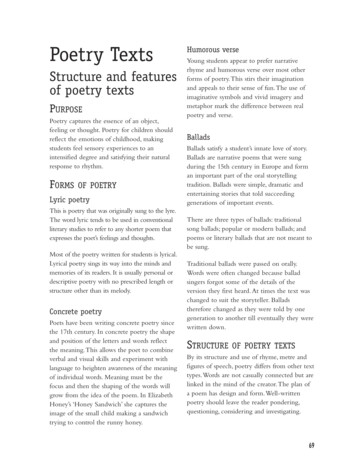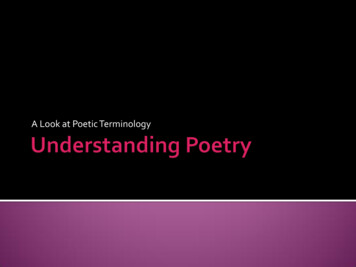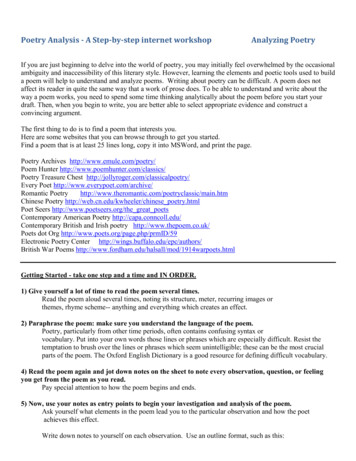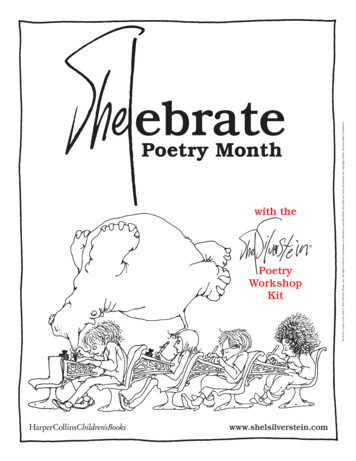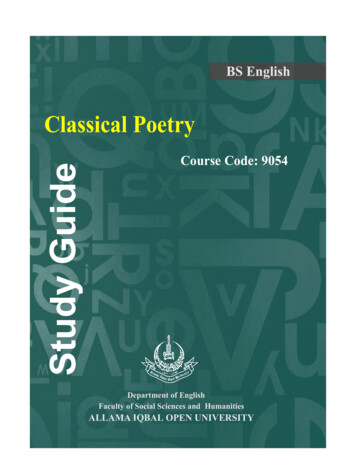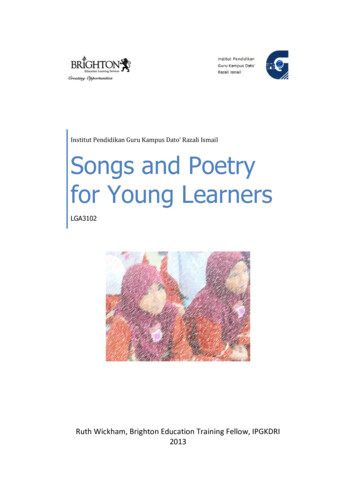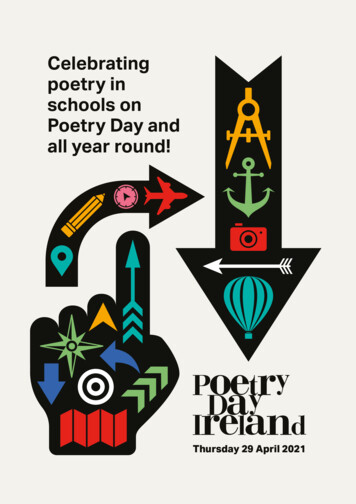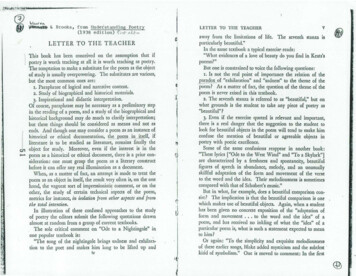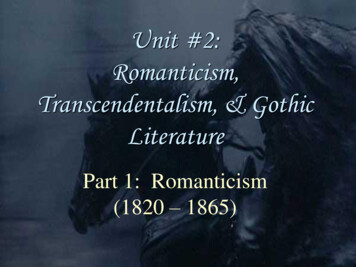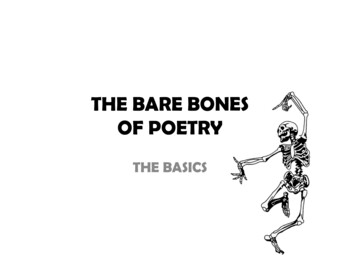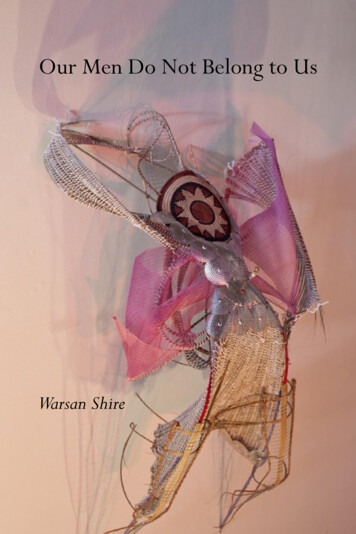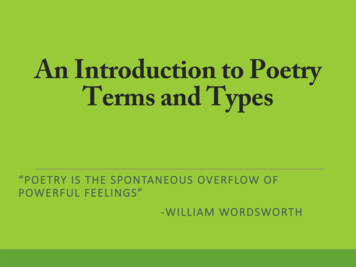
Transcription
An Introduction to PoetryTerms and Types“POETRY IS THE SPONTANEOUS OVERFLOW OFPOWERFUL FEELINGS”-WILLIAM WORDSWORTH
“Poetry is the human soul entire,squeezed like a lemon or a lime,drop by drop, into atomic words Langston Hughes"A poem begins with a lump in the throat; a home-sickness or a lovesickness. It is a reaching-out toward expression; an effort to findfulfillment. A complete poem is one where an emotion has found itsthought and the thought has found the words.”-Robert Frost
What is Poetry?Poetry is arguably the purest form of writing. Poetry is a sense ofthe beautiful. It is art. Like art it is very difficult to define becauseit is an expression of what the poet thinks and feels and may takeany form the poet chooses for this expression.“We don't read and write poetry because it's cute. We read and writepoetry because we are members of the human race. And the human raceis filled with passion. And medicine, law, business, engineering - these arenoble pursuits and necessary to sustain life. But poetry, beauty, romance,love - these are what we stay alive for.”- Mr. Keating, played by Robin Williams in the movie Dead Poets’ Society
Types of PoetryThe subject matter can vary dramatically!Fixed or free form Fixed form is a poem that may be categorized by the pattern ofits lines, meter, rhythm, or stanzas; a style of poetry that has setrules. Ex: sonnet, villanelle, limerick Free Form is a poem that has neither regular rhyme nor regularmeter. Free verse often uses cadences (natural patterns ofspeech) rather than uniform metrical feet.
Types of PoetryFixed Form Poetry can be classified into three categories ormajor types Lyric: Shakespearean Sonnet, Petrarchan Sonnet, Ode,Elegy Narrative: Ballad, Epic, Allegory, Dramatic monologue Dramatic.
Lyric PoetryLyric poetry conveys emotional intensity and relies heavily on musical andrhythmical qualities. Two types of lyric poetry are odes and sonnets. Well-knownauthors of lyric poetry include: Christine de Pizan Teresa of Ávila Antonio Machado T. S. Eliot Shakespeare
Shakespearean/ElizabethanSonnet 14 LINES THREE QUATRAINS RHYMING COUPLET.The image part with relationship ID rId2 was not found in the file. IAMBIC PENTAMETER. COUPLET: TIES UP THE IMAGES ANDFEELINGS AND STATES THE PHILOSOPHYOF THE POET AT THE END.
Petrarchan Sonnet ITALIAN SONNET OCTAVE (8 LINES) SESTET (6 LINES). OCTAVE: THE PROBLEM SESTET: THE SOLUTION BREAK VOLTA OCTAVE: ABBAABBA SESTET:CDECDE OR CDCDC OR CDDCEF.The image part with relationship ID rId2 was not found in the file.
Sonnet ComparisonThe image part with relationship ID rId2 was not found in the file.
Example of a Lyric PoemDo not go gentle into that good night,“Do Not Go Gentle Old age should burn and rave at close of day;Rage, rage against the dying of the light.Into That GoodNight”By Dylan ThomasThough wise men at their end know dark is right,Because their words had forked no lightning theyDo not go gentle into that good night,Good men, the last wave by, crying how brightTheir frail deeds might have danced in a green bay,Rage, rage against the dying of the light.Wild men who caught and sang the sun in flight,And learn, too late, they grieved it on its way,Do not go gentle into that good night,Grave men, near death, who see with blinding sightBlind eyes could blaze like meteors and be gay,Rage, rage against the dying of the light.And you, my father, there on the sad height,Curse, bless, me now with your fierce tears, I pray.Do not go gentle into that good night,Rage, rage against the dying of the light.
Narrative PoetryIn narrative poetry a story is told about societies, cultures,and heroes. Epic poems are very long, many times coveringyears of events; and ballads are another type of narrativepoem. Authors of note include: Geoffrey Chaucer Edgar Allan Poe Henry Wadsworth LongfellowHere is an excerpt from “Hiawatha” by Longfellow:n“On the shore stood Hiawatha, Turned and waved his hand atparting; On the clear and luminous water Launched his birchcanoe for sailing, From the pebbles of the margin Shoved it forthinto the water; Whispered to it, "Westward! westward!" And withspeed it darted forward.”
Dramatic PoetryDramatic poetry is written in verse and is usually meant to berecited. It tells a story or describes an event in a dramatic andinteresting way. Poets of note include: Shakespeare Ben Jonson Christopher Marlowe Rudyard KiplingFollowing is an excerpt from Kipling’s “The Law of the Jungle”.“Wash daily from nose-tip to tail-tip; drink deeply, but never too deep;And remember the night is for hunting, and forget not the day is for sleep.The Jackal may follow the Tiger, but, Cub, when thy whiskers are grown,Remember the Wolf is a Hunter -- go forth and get food of thine own.Keep peace wit hthe Lords of the Jungle -- the Tiger, the Panther, and Bear.And trouble not Hathi the Silent, and mock not the Boar in his lair.”
Free Verse PoetryFree verse is just what it says it is - poetry that is writtenwithout proper rules about form, rhyme, rhythm, andmeter.In free verse the writer makes his/her own rules. The writerdecides how the poem should look, feel, and sound.Most modern poetry is written in free form/verse.
Free Verse PoetryThe image part with relationship ID rId2 was not found in the file.The image part with relationship ID rId2 was not found in the file.- William Carlos WilliamsThe image part with relationship ID rId2 was not found in the file.
VerseKey TermsEnjambmentCaesuraLines & StanzaMeterRhymeRhyme tended MetaphorThe imagepart withrelationshipID rId4 wasnot found inthe file.The image part with relationship ID rId4 was not found in the ne
Verse vs. ProseEnglish has 2 types of writing styles: Verse and ProsePROSE:Most texts we are used to are written in PROSE; they consist of unitslike sentences, and use grammar and punctuation in a prescribedway.VERSE:Poetry is written in VERSE; its units consist of rhyme and meter, not ofgrammatically-correct sentences. Verse is sometimes used as asynonym for poetry.It is possible to mix verse and prose in texts.
SpeakerSPEAKER: in prose fiction we have narrators, and in poetrythe voice is called the SPEAKER in the poemPERSONA: sometimes, the poet uses a “persona”, whichbasically means they create a character and take on thevoice of this character to help convey ideas or emotions.This is sometimes done in lyric and narrative poetry.POLYVOCALITY: the usage of multiple speakers/voices in apoem to convey ideas. This is sometimes done through theuse of bracketed lines ( ) or italics
Lines and StanzasLINE: The basic unit of poetry is the line. It serves the samefunction as the sentence in prose, but usually does not useformal grammatical structures.Most poems have a structure in which each line contains aset amount of syllables; this is called METER.STANZA: Lines are also often grouped into stanza. Thestanza in poetry is equivalent or equal to the paragraph inprose. Often the lines in a stanza will have a specific rhymescheme.
Types of StanzasCouplet: Two rhymed lines.* not always a separate stanzaTercet: a three-line stanza.* called a Triplet when all three lines rhymeQuatrain: a four-line stanza. Very common.Quintet: a five-line stanzaSestet: a six-line stanzaSeptet: a seven-line stanzaOctave: an eight-line stanza
Lines & The Punctuation of PoetryLines of poetry are either “enjambed” or “end-stopped”:Enjambment:moving over from one line to another without a terminating punctuationmark. It can be defined as a thought or sense, phrase or clause in a line ofpoetry that does not come to an end at the line break but moves over tothe next line. Enjambment is a clever poetic trick that can speed up thepace of the poem, maintain rhythm beyond the end of a line, conveymultiple ideas within one line, and encourage readers to keep reading togain meaning!Example:“A thing of beauty is a joy forever:Its loveliness increases; it will neverPass into nothingness but still will keepA bower quiet for us, and asleepFull of sweet dreams, and health, and quiet breathing.”(Endymion by John Keats)
Lines & The Punctuation of PoetryLines of poetry are either “enjambed” or “end-stopped”:End-Stopping:An end-stopped line is a poetic device in which a pause comes at the end of asyntactic unit (sentence, clause or phrase); this pause can be expressed in writingas a punctuation mark such as a colon, semi-colon, period or full stop. Endstopping is used to create regular rhythm, slow down the pace of a poem, provideorder in how information is presented, and can often be more accessible.Example:A little learning is a dangerous thing;Drink deep, or taste not the Pierian spring.There shallow draughts intoxicate the brain,And drinking largely sobers us again.(An Essay on Criticism by Alexander Pope)
Lines & The Punctuation of PoetryCaesura punctuation is also used in poetry.Caesura:A caesura is a pause in a line of poetry that is formed by the rhythms of natural speechrather than by metrics. A caesura will usually occur near the middle of a poetic line, but canalso occur at the beginning or the end of a line. It can also add emphasis. It is annotated likethis: Sometimes a caesura will occur at the beginning of a line, called an 'initial caesura,' or atthe end of a line, called a 'terminal caesura.'Examples1) From John Mole’s “Coming Home”:‘They lie together now. They sleep apart.And still, in dreams, each breaks the other’s heart.’2) First line of Elizabeth Barrett Browning’s “Mother and Poet”:'Dead ! One of them shot by the sea in the east‘ initial caesura
Meter & Poetic FeetMeter is an organized way to arrange stressed/accented syllables and unstressed/unaccented syllables, which are calledPoetic Feet to create rhythm. A Syllable is the smallest sound unit of a word (vowel sounds).A poetic foot is a basic repeated sequence of meter composed of two or more accented or unaccented syllables. In the caseof an iambic foot, the sequence is "unaccented, accented". There are other types of poetic feet commonly found in Englishlanguage poetry.The image part with relationship ID rId2 was not found in the file.The primary feet are referred to using these terms(an example word from Fussell's examples is given next to them):Iambic: destroy (unaccented/accented)Anapestic: intervene (unaccented/unaccented/accented)Trochaic: topsy (accented/unaccented)Dactylic: merrily (accented/unaccented/unaccented)Stressed syllable: /Unstressed syllable: U
Meter & Poetic FeetThe poetic foot then shows the placement of accented and unaccented syllablesin iambic pentameter, for example. It tells us that each foot consists of an IAMB (1stressed 1 unstressed syllable).The second part of the term, pentameter, shows the number of feet per line. Inthe case of pentameter, there are basically five feet per line.Example of iambic pentameter: “In sooth I know not why I am so sad.It wearies me, you say it wearies you;”- Antonio, Shakespeare’s The Merchant of VeniceThe types of line lengths are as follows:One foot: MonometerFive feet: PentameterTwo feet: DimeterSix feet: HexameterThree feet: TrimeterSeven feet: HeptameterFour feet: TetrameterEight feet: Octameter
RhymeRhyme is when the endings of the words sound the same.Dust of Snowby Robert FrostThe way a crowShook down on meThe dust of snowFrom a hemlock treeHas given my heartA change of moodAnd save some partOf a day I had rued.
Rhyme SchemeRhyme scheme is the pattern of rhyming words at the end of each line. Not allpoetry has a rhyme scheme. They are not hard to identify, but you must lookcarefully at which words rhyme and which do not.Poems of morethan one stanzaoften repeat thesame rhymescheme in eachstanza.Dust of Snowby Robert FrostThe way a crowShook down on meThe dust of snowFrom a hemlock treeHas given my heartA change of moodAnd save some partOf a day I had rued.ABABCDCD
Internal RhymeInternal Rhyme – rhyme within a lineTime, Slime, MimeInternal Rhyme – Scornfully scaly snake which heldhis very fateWhile I nodded nearly napping, suddenly therecame a tapping
Half RhymeHalf Rhyme can be defined as a rhyme in which the stressed syllables of endingconsonants match, however the preceding vowel sounds do not match.For instance, in words such as “shape/keep” the consonance is very strong. The finalconsonant sounds remain similar but the ending vowel sounds are different in halfrhyme.Half rhyme is generally used to give an inharmonious feeling in a rhyme scheme, andcan help convey and reflect the subject of the poem.More Examples: “moon” and “run” ; “hold” and “bald”That is no country for old men. The youngIn one another’s arms, birds in the trees– Those dying generations – at their song,The salmon-falls, the mackerel-crowded seas,Fish, flesh, or fowl, commend all summer long- W.B. Yeats, from “Sailing to Byzantium”ababa
RepetitionRepetition is the repeating of a sound, word, or phrase for emphasis.COMMON TYPES OF REPETITION:1) Anadiplosis: Repetition of the last word in a line or clause at thebeginning of the next one.2) Anaphora: Repetition of words at the start of clauses or lines.3) Epiphora: Repetition of the same word at the end of each lines.4) Epimone: Repetition of a phrase (usually a question) to stress apoint.5) Epizeuxis: Repetition of a word or phrase in quick succession, oneafter another or very close together, for strong emphasis.6) Polyptoton: Repetition of the same root word (dream, dreamer, dreaming)I looked upon the rotting sea,And drew my eyes away;I looked upon the rotting deck,And there the dead men lay.And then the wall rose,Rose slowly,Slowly,Between me and my dream.Samuel Coleridge, “The Rime of the Ancient Mariner”Langston Hughes, “As I Grew Older”
RepetitionRepetition is the repeating of a sound, word, or phrase for emphasis.MORETYPES OF REPETITION & STRUCTURAL DEVICES:Isocolon - A series of structured phrases or clauses having the samelength or grammatical structure. A kind of parallelism. (*ex. slide 50)Tricolon - Listing of three parallel elements of the same lengthoccurring together.Antanaclasis - The repetition of a word or phrase whose meaningchanges in the second instance.Symploce - The combination of anaphora and epistropheDiacope - Repetition of a word with one or more between, usually toexpress deep feelingI came, I saw, I conquered. – Julius Caesar TRICOLONThe yellow fog that rubs its back upon the window-panes,The yellow smoke that rubs its muzzle on the window-panes . . ." SYMPLOCE“Put out the light, then put out the light ” (Othello). ANTANACLASIS(T.S. Eliot, "The Love Song of J. Alfred Prufrock." Prufrock and Other Observations, 1917)The first meaning is that Othello would extinguish the candle, and in the second reference its meaning is that he would end Desdemona’slife.
ToneThe author’s attitude about a subject This is implied throughout the work through style and language (like diction,punctuation, syntax, imagery, etc.)"I shall be telling this with a sigh/Somewhere ages and ages hence:/Two roads diverged in a wood, and I,/I took the one less traveled by,/And that has made all the difference."-From “The Road Not Taken” By Robert Frost In this example, Frost is commonly interpreted as looking back on his experiencewith joy. That is true, if he were to speak those lines cheerfully. However, imaginethat he actually sighs when he says "sigh" and he appears sullen when he says "Andthat has made all the difference." The entire meaning of the poem is changed, andFrost is, indeed, not thrilled with the choice he made in the past.
VoltaIn poetry, the volta, or turn, is a rhetorical shift or dramatic change inthought and/or emotion. Turns are seen in all types of written poetry.Author and historian Paul Fussell calls thevolta "indispensable."[5] He states furtherthat "the turn is the dramatic and climacticcenter of the poem, the place where theintellectual or emotional method of releasefirst becomes clear and possible.
Figurative LanguageWhenever you describe something by comparing itwith something else, you are using figurative language.Figurative language is any language that goes beyondthe literal meaning of words in order to furnish neweffects or fresh insights into an idea or a subject. Themost common figures of speech are simile, metaphor,and alliteration. Figurative language is used in poetryto compare two things that are usually not thought ofas being alike.
SIMILEA comparison using like or as.The image part with relationship ID rId2 was not found in the file.The image part with relationship ID rId2 was not found in the file.EXAMPLES: As brave as a lion, As dumb as an ox- The call to war has made young men “as swimmers intoclearness leaping” according to Rupert Brooke’s poem,“Peace.”
METAPHORA figure of speech in which one thing is spoken asthough it were something else, a direct comparisonof two unlike things.Clouds are cotton candy.They are fluffy.War is a game with norules.War is chaotic.
ANALOGYA figure of speech that compares two essentially unlikethings at some length and in several ways (an extendedmetaphor).EXAMPLE:“All the world’s a stage, And all the men andwomen merely players.”--William Shakespeare, As You Like It
PERSONIFICATIONFigurative language in which a nonhuman subject isgiven human characteristicsEXAMPLE:The wind gently called her name.My country bore and raised me.RELATED TERMS:Anthropomorphism giving animals human qualitiesZoomorphism giving humans animal qualities
ALLITERATIONRepetition of the same, initial consonant soundsEXAMPLE: Soft Sighing of the SeaThe image part with relationship ID rId2 was not found in the file.
CONSONANCERepetition of internal or ending consonant sounds ofwords close together in poetry.Blow! Bugles! Blow!windows, doors through, ruthless;scatter, congregation- “Beat! Beat! Drums!” by Walt WhitmanCACOPHONY: the use of words with sharp, harsh,hissing, and unmelodious sounds – primarily those ofconsonants – to achieve desired results.
ASSONANCEThe repetition of the vowel sounds followed by differentconsonants.EXAMPLES:As high as a kite in a bright skyMy words like silent rain drops fellEUPHONY: The use of words and phrases that havemelody or pleasantness in the sounds they create. It givessoothing effects to the ear due to repeated vowels (likeassonance) and sometimes smooth consonants.
SIBILANCESibilance is a literary device where strongly stressed consonants are useddeliberately to produce hissing sounds. Most of the times, the “s” sound isthe sibilant.With the help of sibilance, descriptive scenes can be explained morecarefully by laying stress on the specific letters. Often, the harsh “hissing”sound can reflect a bitter or harsh mood.Example:THE WINTER evening settles downWith smell of steaks in passageways.Six o’clock.The burnt-out ends of smoky days.And now a gusty shower wrapsThe grimy scrapsOf withered leaves about your feet from “Prelude 3”, by T.S. Eliot
ONOMATOPOEIAThe use of words that imitate sounds.Often to help visualize events or situations andThe image part with relationship ID rId3 was not found in the file.Increase the readers’ participationooze, quack, woof, sizzlebang, buzz, thud, hiss
The image part with relationship ID rId2 was not found in the file.IMAGERYUsually these words or phrases createa picture in the reader’s mind. Someimagery appeals to the other FIVEsenses (sight, hearing, touch, taste,smell).EXAMPLES: Sight (Visual) – smoke mysteriously puffed out from his ears Sound (Auditory) – he could hear a faint but distant thump Touch (Tactile) – the burlap wall covering scraped his skin Taste (Gustatory) – a salty tear ran down his cheek Smell (Olfactory) – the scent of cinnamon floated into his nostrils Bodily sensations (Organic) – His leg throbbed with pain.
ALLUSIONAn brief and/or indirect reference to a famous person, place,event, or literary work. This relies on the reader to makeconnections and understand the significance of the allusion.EXAMPLES:1. The rise in poverty will unlock the Pandora’s box of crimes. –This is an allusion to one of Greek Mythology’s origin myth,“Pandora’s box”.2. She is such an Einstein!3. He’s battling with the whole “to be or not to be” question
SYMBOLISMSymbolism is the use of objects, ideas, people, places, colours, animals, etc. tosignify ideas and qualities by giving them meanings that are different from theirliteral sense.Symbols can shift their meanings depending on the context they are used in. “Achain”, for example, may stand for “union” as well as “imprisonment”. Thus,symbolic meaning of an object or an action is understood by when, where andhow it is used. It also depends on reader responses and personal associations.EXAMPLES:- The dove is a symbol of peace.- A red rose or red color stands for love or romance.- Black is a symbol that represents evil or death.
MOTIFA recurring image or pattern of imagery/symbolism in a literary work.Example:The words “sun”, “river”, “earth”, “grass”, “dust”, and “soil” are allrelated to nature, creating a nature MOTIF in the WW1 poem “TheSoldier”F.Scott Fitzgerald uses motifs of colour, nature, and eyes throughout TheGreat Gatsby to develop his themes.
ALLEGORYA work with two levels of meaning—a literal one and asymbolic one. Animal FarmThe image part with relationship ID rId3 was not found in the file.The image part with relationship ID rId3 was not found in the file.The image part with relationship ID rId3 was not found in the file.Literally about animals who overtaketheir farm and run it themselves.Symbolically, it is about theRussian Revolution and Stalin’srule.
HYPERBOLE & LITOTESHYPERBOLE: A bold, deliberate overstatement notintended to be taken seriously. The purpose is toemphasize the truth of the statement.He weighs a ton.I could eat a horse.My parents are going to kill me.LITOTES: a deliberate understatement (sometimes using adouble negative) for effect.Ex: Shakespeare was a pretty decent playwright.She is not unlike her mother.
OXYMORONThe junction of words which, at first view, seem to becontradictory, but surprisingly this contradictionsexpresses a truth or dramatic effect.EXAMPLES:Pretty uglyJumbo ShrimpBeautiful disaster
JUXTAPOSITIONJuxtaposition is a literary technique in which two ormore ideas, places, characters and their actions areplaced side by side in a narrative or a poem for thepurpose of developing comparisons and contrasts.“It was the best of times, it was the worst of times, it was the age ofwisdom, it was the age of foolishness, it was the epoch of belief, it wasthe epoch of incredulity, it was the season of Light, it was the seasonof Darkness, it was the spring of hope, it was the winter of despair, wehad everything before us, we had nothing before us Charles Dickens, A Tale of Two CitiesJuxtaposition highlights the disparity in France prior to the French Revolutionand inequality that fueled it. Readers sense the tension and atmospherecreated through the phrasing of these contrasting ideas. * This is alsoISOCOLON (parallel sentence structure)
DICTION & ConnotationsA writer’s or speaker’s choice of words and way of arranging thewords in sentences.Words have denotations (dictionary, factual definition/description) and connotations (ideas, feelings, associations that aword evokes apart from its definition)Connotationsevil or dangerGrossScarySin (biblical)DenotationsSnakeThe image part with relationship ID rId2 was not found in the file.any of numerous scaly,legless, sometimesvenomous reptiles;having a long,tapering, cylindricalbody and found inmost tropical andtemperate regions
LEXICAL CLUSTERINGThis is when a text includes a collection of words which are related toone another through their similar meanings, associations (connotations)or through a more abstract relation.This technique is often used by writers to keep a certain imagepersistent in their readers' mind.Example:This is a valley of ashes--a fantastic farm where ashes grow like wheat intoridges and hills and grotesque gardens where ashes take the forms of housesand chimneys and rising smoke and finally, with a transcendent effort, of menwho move dimly and already crumbling through the powdery air. - F. Scott Fitzgerald, The Great Gatsby (Chapter 2)* What images of the valley of ashes are strongly conveyed throughFitzgerald’s use of lexical clustering?
METONYMYA figure of speech that replaces the name of a thing with the name ofsomething else with which it is closely associated.Examples:1) The pen is mightier than the sword.The "pen" stands in for "the written word. "The "sword" stands in for"military aggression and force.”Read more at onymy.html#AF5xL0JF77Yy84RQ.992) A gun or weapon used to represent war
SYNECDOCHEThere are several different forms of synecdoche examples including:A synecdoche may use part of something to represent the entire whole.It may use an entire whole thing to represent a part of it.Examples:-The phrase "hired hands" can be used to refer to workmen.-- The word "wheels" refers to a vehicle.-The word “suits” refers to businessmen.
ReflectionTake out a sheet (or ½ sheet) of paper and answer the following in pointform:- List 2 things that you like about poetry, poets or poems you enjoy, oractivities that you have liked when covering poetry before.- List 2 things that you do not like about poetry or about activities thatyou have completed before related to poetry.-- Hand to me before you leave!
Poetry is a sense of the beautiful. It is art. Like art it is very difficult to define because it is an expression of what the poet thinks and feels and may take any form the poet chooses for this expression. "We don't read and write poetry because it's cute. We read and write poetry because we are members of the human race. And the human race
